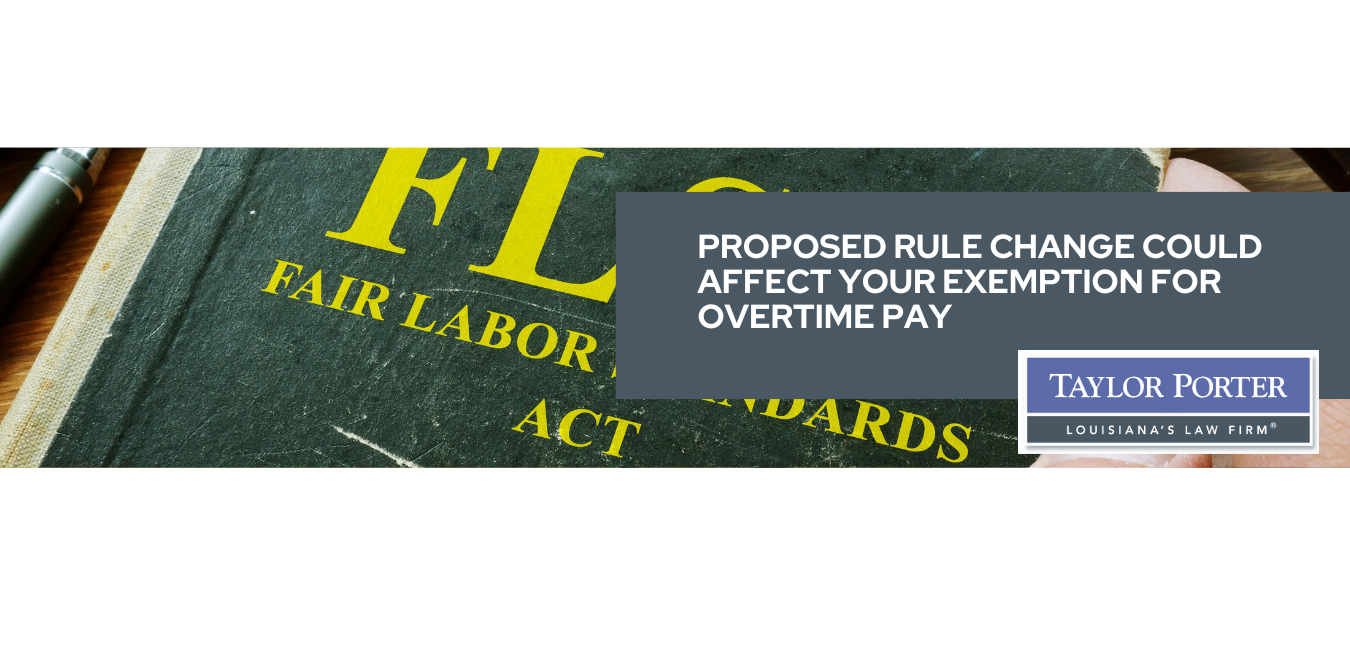COVID-19 Related Closings and Layoffs – What You Need to Know About the WARN Act
By John Andrishok
Special Counsel, Taylor Porter
john.andrishok@taylorporter.com
 Despite recent Federal legislation designed to encourage employers to maintain employees on their payroll, large scale layoffs, furloughs, and reductions in pay, both temporary and permanent, are inevitable as a result of the current pandemic. In 1988, Congress passed the Worker Adjustment and Retraining Notification (WARN) Act to provide notice to employees of impending mass layoffs and plant closings. In general, the WARN Act requires employers who are planning a plant closure or mass layoff to give affected employees at least sixty (60) days prior written notice of such employment action. The Act is intended to provide affected workers advance notice of the layoffs and afford them sufficient time to seek alternative employment. While it sounds relatively straightforward, there are numerous traps for the unwary which can result in stiff fines of up to $500 per day, back pay to each affected employee for up to sixty (60) days and attorneys fees. As the Department of Labor has no legal standing to enforce the Act, class actions are the most frequent means to seek redress.
Despite recent Federal legislation designed to encourage employers to maintain employees on their payroll, large scale layoffs, furloughs, and reductions in pay, both temporary and permanent, are inevitable as a result of the current pandemic. In 1988, Congress passed the Worker Adjustment and Retraining Notification (WARN) Act to provide notice to employees of impending mass layoffs and plant closings. In general, the WARN Act requires employers who are planning a plant closure or mass layoff to give affected employees at least sixty (60) days prior written notice of such employment action. The Act is intended to provide affected workers advance notice of the layoffs and afford them sufficient time to seek alternative employment. While it sounds relatively straightforward, there are numerous traps for the unwary which can result in stiff fines of up to $500 per day, back pay to each affected employee for up to sixty (60) days and attorneys fees. As the Department of Labor has no legal standing to enforce the Act, class actions are the most frequent means to seek redress.
Which Businesses Are Required to Give Notice?
The Act applies to: a) businesses with 100 or more full-time employees (excluding those employed for less than six (6) months and part-time employees); and b) businesses employing 100 or more employees who work at least a combined 4,000 hours per week. The Act applies to private for profit businesses, private non-profit organizations, or quasi-public entities separately organized from the government. Workers on temporary leave who reasonably expect to be recalled are counted as employees.
Which Employees Are Entitled to Receive a WARN Notice?
Covered employees may be hourly or salaried workers, managerial, supervisory and non-striking employees. Employees include: 1) Employees terminated or laid off for more than six (6) months or who have their hours reduced by 50% or more in any six (6) month period as a result of a plant closing or mass layoff; 2) Employees who may be reasonably expected to experience an employment loss as a result of a proposed plant closing or mass layoff; 3) Employees who are on a temporary layoff but have a reasonable expectation of a recall(includes workers on workers’ compensation, medical, maternity or other leave); and 4) Part-time workers. Note that while part-time workers are not included for the purposes of determining whether a mass layoff or plant closing has occurred, they are entitled to notice in the event of an expected job loss.
Employees on Strike, locked out workers, employees working on temporary projects or facilities, business partners, consultants, contract workers, or regular federal, state, and local governmental employees are not entitled to notice.
When is a WARN Notice Requirement Triggered?
Plant Closing. A WARN notice is required when a business closes a facility or discontinues an operating unit permanently or temporarily and at least fifty (50) employees (not including part-time) are affected at a single site of employment during a thirty (30) day period. The closing of multiple facilities or operating units within a single site of employment would also trigger the notice requirement so long as a total of fifty (50) or more employees are affected. The fact that a few employees remain for maintenance or security purposes does not preclude a finding of a plant closing. Also note that while temporary employees are counted in determining whether a plant closure has occurred, such workers are not entitled to the required notice.
Mass Layoffs. Similarly, laying off more than 500 workers (not counting part-time) at a single site during a thirty (30) day period or layoffs of 50-499 employees which constitute 33% of the workforce at a particular site will trigger the notice requirement. The general rule is that separate facilities are considered separate sites. However, a narrow exception to this general rule is that geographically separate sites with an inextricable operational connection — that is, separate sites that are used for the same purpose and share the same staff and equipment — can constitute a single site of employment.
Exception to 30 day rule. In determining whether a plant closing or mass layoff has occurred or will occur, employment losses for two (2) or more groups at a single site of employment, each of which is less than the minimum number of employees specified, but which in the aggregate exceeds that minimum number, and which occur within any 90-day period shall be considered to be a plant closing or mass layoff unless the employer demonstrates that the employment losses are the result of separate and distinct actions and causes and are not an attempt by the employer to evade the requirements of the Act.
Temporary Layoffs. A WARN notice is required when a temporary layoff which was originally scheduled to last less than six (6) months, becomes permanent. This only applies when the permanent nature of the layoffs was not known or foreseeable. Notice deadlines commence from the date that it was reasonably foreseeable to the employer that the temporary layoffs would exceed six (6) months.
Reduction of Hours. A WARN notice is also required when a reduction of hours for 50 or more employees by 50% or more occurs for each month in a six (6) month period.
Exceptions to the 60-day Notice Rule.
A company is excused from providing sixty (60) days prior notice in any of the following circumstances: 1) the company has in good faith sought additional capital to maintain operations but fails to obtain the required funding; 2) the circumstances were not reasonably foreseeable; or 3) when the circumstances were the result of a natural disaster. The regulations provide that a "government ordered closing of an employment site that occurs without prior notice" constitutes an unforeseeable event. The Department of Labor has not provided guidance to date. However, it would certainly appear that the current Covid-19 pandemic would constitute an unforeseeable event as opposed to a natural disaster. In these circumstances, written notice is still required and must be provided as soon as practicable.
The Notice
The notice must be in writing and sent to all affected employees. The notice must include the following: 1) a statement of whether the planned action is temporary or permanent and whether the entire plant or facility will be closed; 2) the expected date when the closing or layoffs will commence and when the employee will be terminated; 3) any seniority rights; and 4) contact information for any follow up information. WARN notices may identity a two (2) week period within which the layoff may take place. In the event that a union contract is in place, notice to the business agent may be required. Louisiana employers should send a separate notice to the Louisiana Workforce Commission. See http://www.laworks.net/WorkforceDev/WFD_WARNContactInfo.asp
The Federal Regulations are helpful and can be found at https://www.ecfr.gov/cgi-bin/text-idx?SID=99ed6ca6283e86ebd5f28437ff29ba23&mc=true&node=pt20.3.639&rgn=div5
If you have any further questions, please do not hesitate to contact any member of the Taylor Porter Employment, Labor & Benefits Practice Group. We will continue to alert you of these updates and post any news and legal developments to our Coronavirus Legal Blog and Resources section of our website.
About John Andrishok: Practicing law since 1997, Taylor Porter Special Counsel John Andrishok represents clients in labor and employment law and construction litigation.
This website is for general information purposes only. Information posted is not intended to be legal advice. For more information, please see our Disclaimer message.
See how we can help. Contact us today
8th Floor • 450 Laurel Street • Baton Rouge, LA 70801 • 225-387-3221
- Disclaimer
- © Taylor, Porter, Brooks & Phillips L.L.P. All rights reserved.






